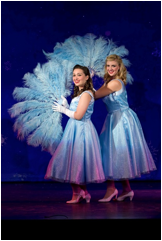Dance Fans for White Christmas
Billy Wilburn and Corey Shelsta
South Dakota State University Theatre
For our production of White Christmas we needed to very large feather fans the song Sisters. We looked at purchasing them, but the cost of each would have been hundreds of dollars. We wanted a strong, theatrical quality fan that could stand up to hours of rehearsal and performance so a cheap plastic version from the local craft store was out of the question.
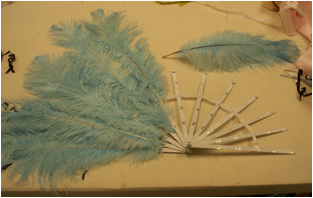
We first made a mock up by cutting 16 pieces of 1/8” thick x ½ wide steel rectangular bar into 24” lengths. We laid them out in a fan shape to get the basic look. After some experimenting we determined that 12 bars would be appropriate and the length was reduced to 18”. When stacked, the 12 bars were a bit too thick and we had yet to add the spacers or the feathers. We decided to go with 1/16” stock instead. Weight of the steel was not considered as we had intended to use aluminum for the final product.
We purchased five pieces of aluminum (Architectural Aluminum (alloy 6063), Rect Bar W/ Rounded Edge, 1/16" Thk X 1/2" W X 6'l ), McMaster-Carr stock #490T11. We cut the bar into 18” lengths, and drilled a hole ½” from the bottom of each for the bolt that would hold the blades together. We drilled 4 smaller holes, spaced about 3” apart down the length of the blades to allow for the feathers to be sewn on. All of the edges and drill holes where then ground down to insure there were no burrs or sharp edges that could damage the delicate feathers. After preparation the blades were sprayed white.
A bolt was inserted through the hole at the bottom of the first blade. 1/8” nylon spacers were placed between each blade as they were stacked on the bolt. This allowed for smoother movement and space for the feathers between each. A locking nut was secured on the end of the bolt once the blades were in place.
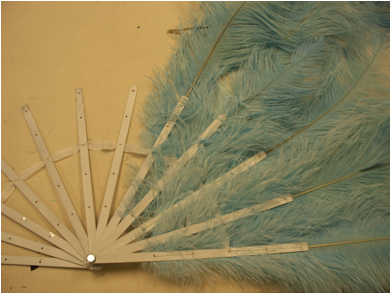
A fabric band was constructed to keep the blades properly spaced when the fan was opened. Once this band had been attached to the blades the feathers were sewn on. Two feathers were used on each blade, one at the bottom and one nearer the end. This provided the amount of volume we were looking for in the fans.
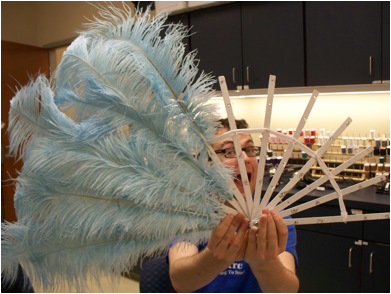
To achieve the right color for the feathers we used a silk dye and dipped each feather. After the feathers were dry we then combed and steamed each feather to restore the volume. To attach the feathers to the aluminum frame we used button thread. It did take a long while to sew on the feathers but the final product was worth it.
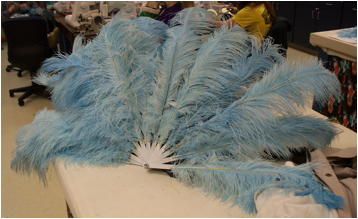
While the feathers were not inexpensive, by making these ourselves we saved several hundred dollars. The final product was lightweight and durable. It looked great on stage and had no problems during rehearsals or performances.
